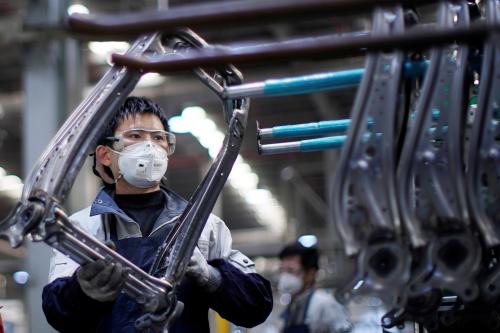The following is an excerpt from Reopening the World: How to Save Lives and Livelihoods, a new report where Brookings experts offer ideas to help policymakers protect lives and save livelihoods in the midst of the current COVID-19 pandemic.
 Like other countries around the world, the U.S. is beginning to re-open while coronavirus transmission persists in many communities and before a vaccine has been discovered. This suggests demand for key medical goods—including medicines, coronavirus tests, ventilators, and crucial personal protective equipment (PPE) such as N95 masks—will remain high, both as precautionary measures and to respond to localized flare-ups or a possible second wave of the virus. Supply of such goods has and will continue to increase. But even with an aggressive push to increase production, supply is unlikely to be sufficient to meet the 20-fold increase in demand.
Like other countries around the world, the U.S. is beginning to re-open while coronavirus transmission persists in many communities and before a vaccine has been discovered. This suggests demand for key medical goods—including medicines, coronavirus tests, ventilators, and crucial personal protective equipment (PPE) such as N95 masks—will remain high, both as precautionary measures and to respond to localized flare-ups or a possible second wave of the virus. Supply of such goods has and will continue to increase. But even with an aggressive push to increase production, supply is unlikely to be sufficient to meet the 20-fold increase in demand.
During the first wave of the coronavirus outbreak, the federal government struggled to get medical goods to the people and places that needed them. It initially left distribution to market mechanisms—sparking price spirals and accusations of gouging by profiteers as state governments and hospital systems bid against one another, desperately seeking supplies. More recently, the government began blocking the export of certain medical goods, cutting off trade flows to countries in need.
Looking forward, the U.S. needs to avoid the pitfalls of both the wild west of unfettered markets and the threat of every-country-for-themselves economic nationalism. To reopen while preventing the price spirals, trade restrictions, and shortages that have so far plagued medical goods markets, the U.S. government should cooperate with other countries around the world to better organize and coordinate the procurement and international distribution of key medical goods. By establishing communication channels and coherently planning the demand and supply of such products, governments can build trust in each other and lay the foundation for more effective management of global health.
Calling for global cooperation during a crisis may seem far-fetched, yet history shows that it is precisely during emergencies that the need for cooperation to achieve public goods can spur government action.
FROM MARKET PANDEMONIUM TO ECONOMIC NATIONALISM
Through the early months of the coronavirus pandemic, the U.S. government largely refrained from intervening in markets for medical goods. The result was chaos: governors and hospitals found themselves competing against one another, struggling to evaluate a dizzying array of offers from amateur brokers while bidding up prices to astronomical levels. Ambitious middlemen and profiteers cashed in while doctors and nurses scrambled to make do with what they could find. As economists often note, one virtue of market mechanisms and price signals is to allocate goods where demand is highest. Yet price signals conflate both willingness to pay and ability to pay—and in the current context, allocating COVID-19-related medical goods to those who can best afford it does not necessarily align with public interests.
Partially in response to such market failures, more recently the federal government has stepped in— but in ways that are sometimes counterproductive. In early April, the government announced it would restrict exports of certain PPE goods. To be sure, the United States is not alone in taking such actions: in the face of stark shortages and spiraling prices, many governments have attempted to prevent medical goods from leaving their country. Based on data collected by the International Trade Centre, as of May 10, around 95 countries have introduced some form of temporary export restrictions related to COVID-19. Though these limits may boost domestic supply, they simply shift the costs of supply shortages on to other countries; and as the escalating number of countries implementing such restrictions suggests, they risk spiraling protectionism that leaves everyone worse off.
Thankfully, governments have begun to correct some of their earlier missteps. The European Union, which was one of the first to impose an export licensing regime, has since revised its policy to limit the number of goods facing restrictions, include further humanitarian exceptions, and ensure transparency of all licensing decisions. Similarly, the United States has eased some of its licensing restrictions, allowing for continued exports to Canada and Mexico and for exports donated by nonprofit agencies.
COOPERATIVE MANAGEMENT OF MEDICAL SUPPLY CHAINS
While these corrections are welcome, we are still far from what is needed: international coordination to promote a more orderly distribution of medical goods. Calling for global cooperation during a crisis may seem far-fetched, yet history shows that it is precisely during emergencies that the need for cooperation to achieve public goods can spur government action. For instance, during World War I, Western Allies initially found themselves bidding against one another on crucial agricultural commodities, namely wheat. Just as is the case with medical goods today, the result was spiraling prices and further shortages. In the face of this challenge, the United Kingdom, France, and Italy came together in 1916 to found the Wheat Executive, a centralized body that coordinated all wheat purchases for the three countries. This cooperation expanded the following year with the formation of the Allied Maritime Transport Council, which brought together the U.S., UK, France, and Italy to oversee the allotment of shipping tonnage to ensure transport capacity was available where it was most needed, rather than relying on decentralized market distributions. These examples show how, in the face of politically salient shortages, government leaders can strike creative agreements to avoid both the tyranny of markets and beggarthy-neighbor economic nationalism. Similar efforts are needed today.
Coordination of procurement is essential for the world’s poorest countries, which otherwise will be battered by either a market distribution system (as they will be outbid by richer countries) or an economic nationalist approach (as they depend on imports for meeting domestic medical supply needs). But it is also squarely in the United States’ more narrowly defined national interest. Given existing chaos, price spikes, and shortages in the U.S. medical goods market, the American healthcare system would directly benefit from a more orderly and coordinated distribution system. Greater coordination at the international level also would complement greater coordination at the domestic level, as the House of Representatives is currently pushing for. Similarly, the fact that the U.S. imports five times more PPE than it exports underlines that the U.S. stands to lose out overall if every country were to block medical trade.
Moreover, leading a coordinated international response to shortages in COVID-19-related medical goods could help restore America’s international reputation, which has been marred by accusations of “piracy” in seeking to amass PPE. In a recent survey of American foreign policy experts, only 3 percent of respondents rated U.S. leadership in coordinating the international response to COVID-19 as either somewhat or very effective, with over 80 percent rating the response as “not effective at all.” Facilitating a coordinated distribution system could begin to recast such perceptions, and simultaneously help counter China’s “mask diplomacy” efforts.
What might such a coordinated program look like in practice? Ideally, governments would enter a cooperative arrangement to oversee the distribution of PPE and other medical goods, minimizing any hoarding and allocating goods to the people and places where they’re most needed. Crucially, this could include pooled procurement: rather than competing against one another and bidding up prices, governments would jointly purchase needed medical goods, taking advantage of their buying power to negotiate fair prices. Pooled procurement can also allow buyers to commit to large future purchases, based on their combined forecast demand, incentivizing the investments needed to increase supply. Similar pooled procurement mechanisms have been used for years in acquiring pharmaceutical products, particularly for developing countries; there are certainly lessons from these experiences that could apply to purchases of PPE today.
Achieving such levels of cooperation can be difficult, however, particularly given low levels of trust between national governments at present. Indeed, it was a full two years into the First World War before the Wheat Executive was created, which suggests developing such mechanisms can take time. Thus, if governments are unable or unwilling to enter into an arrangement for coordinating the distribution of COVID-19-related medical goods, a possible intermediate step is to improve information sharing and transparency in policymaking. Simply put, governments should inform one another of their supply and demand for specific medical goods, their purchasing plans, and especially any trade policies or export restrictions that will influence global markets.
The Agriculture Market Information System (AMIS), created by the G-20 in the wake of food price spikes in 2007–08 and 2010, provides a potential model. AMIS is an information clearing house where governments share market and policy guidance for key agricultural crops and a forum for informal coordination among policymakers, particularly during times of crisis. A similar mechanism for sharing information and discussing policy developments for COVID-19- related medical goods could improve outcomes even without governments ceding any decision–making power to a cooperative body.
PREPARING FOR A VACCINE
There is a pressing immediate need for better coordination of existing COVID-19-related medical goods. Looming on the horizon, however, is an even more challenging international distribution problem: allocating doses for a coronavirus vaccine, once one is discovered. Competition for the vaccine will undoubtedly be stark, and without coordination rival bids will send prices skyrocketing. Efforts today to build trust and establish communication channels in distribution of PPE and other medical goods will lay the groundwork for future cooperation on a potential vaccine. Just as during WWI efforts to coordinate wheat distribution led to the broader program on coordinated shipping, mechanisms developed now can potentially evolve into a system for allocating vaccines in the future.





Commentary
Reopening the World: Coordinating the international distribution of medical goods
June 30, 2020